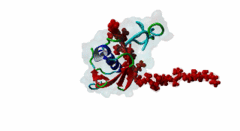| Accession: | |
|---|---|
| Functional site class: | SUMO interaction site |
| Functional site description: | Non-covalent binding to SUMO proteins is mediated via the SUMO-interacting motif (SIM). SUMO-interacting proteins predominantly function in the nucleus. The SIM is essential for a variety of cellular processes including transcriptional regulation, sub-nuclear localization, nuclear body assembly, and anti-viral response. Viral proteins are also known to utilize such processes via their SIMs upon host cell invasion. |
| ELMs with same tags: | |
| ELMs with same func. site: | LIG_SUMO_SIM_anti_2 LIG_SUMO_SIM_par_1 |
| ELM Description: | This SUMO interacting motif variant is for SIMs bound as a beta-augmented strand in the parallel orientation. The SIM peptide inserts into a groove on the SUMO surface so that the motif has a hydrophobic core of four residues (preference V, I or L), the 3rd position being more variable. At the variable 3rd position, in addition to hydrophobic residues, acidic residues (D or E) and the phosphorylatable residue serine are allowed. A stretch of 1 to 5 acidic or phosphorylatable residues is considered necessary C-terminally from the hydrophobic core. Another negative stretch N-terminal to the core appears more optional, though both are usually present. These acidic stretches complement positively-charged residues on the SUMO surface. The length of the acidic stretch may be involved in determining the orientation of binding. When the longer acidic stretch is C-terminal, the beta strand seems usually to be parallel. The two crystal structures of PIAS2 (2ASQ, Song,2005, O75928) and Daxx (2KQS, Chang,2011, O75928) support this theory: They both bind in parallel orientation and have a C-terminal acidic stretch. The crystal structure of RanBP2 (1Z5S, Reverter,2005, P49792) can be contrasted: It binds as an anti-parallel beta strand and has an N-terminal acidic patch. Because of the high similarity of the motif patterns for the parallel and antiparallel orientations, many SIMs will be detected by both of the motifs in ELM. Quite possibly, some SIM peptides may be able to bind to SUMO in both orientations. |
| Pattern: | [DEST]{0,5}.[VILPTM][VIL][DESTVILMA][VIL].{0,1}[DEST]{1,10} |
| Pattern Probability: | 0.0045452 |
| Present in taxon: | Eukaryota |
| Interaction Domain: |
Rad60-SLD (PF11976)
Ubiquitin-2 like Rad60 SUMO-like
(Stochiometry: 1 : 1)
|
A SUMO-Interacting Motif or SIM (also known as SBM, for SUMO-Binding Motif) is a short linear motif that mediates non-covalent binding of SIM-containing proteins to SUMO. Known instances of SIM function in the nucleus. SIM-containing proteins are involved in cellular functions such as transcriptional regulation, subnuclear localization, nuclear body formation, DNA repair regulation, myeloid formation, tumor suppressor activation, control of differentiation/proliferation, targeting substrates for ubiquitin-mediated proteasomal degradation, and enhancement of sumoylation efficiency. It is of note that eukaryotic cells also utilize SIMs for anti-viral response (e.g. SIM is essential for PML’s (P29590) restriction activity of HSV-1 viral replication (Cuchet,2010)), whereas viruses in turn use SIM for transcriptional control of the host cell (e.g. SIM is essential for the trans-activation function of IE2 (Q6SWV3) protein of HCMV (Kim,2010)). Different SIM motif patterns have been suggested in the literature, but most of these match a limited number of known SIMs (Zhao,2014). The minimal region common to all known SIM instances and required for SIM function is a hydrophobic patch consisting of 3 to 4 hydrophobic residues (I, V, or L) with an optionally single variable residue at the 2nd or 3rd positions. At the variable position, beside hydrophobic residues, acidic- and phosphorylatable residues are alsoallowed. The hydrophobic core is extended at least on one side by a variable length stretch of residues composed of phosphorylatable residues (mainly Serine) and acidic residues. Acidic residues and phosphorylated Serine/Threonine residues increase the affinity of binding to SUMO due to interactions with basic residues of SUMO on the SIM interaction interface. Moreover, phosphorylation of the SIM provides a potential for regulation of sumoylation efficiency and fine-tuning the affinity of binding to SUMO, for instance S737 and S739 in Daxx (Q9UER7) (Chang,2011). Structural analyses of SIM complexed with SUMO have reported similar but slightly different binding patterns. All structurally solved instances of SIM bind as an extra beta strand in a hydrophobic pocket formed by the second beta strand and the single alpha helix of SUMO. The SIMs can bind in both directions to the hydrophobic pocket and therefore bind by either parallel or antiparallel beta-augmentation to the beta sheet of SUMO. RanBP2 (1Z5S) (Reverter,2005) and M-IR2 (2LAS) (Namanja,2012) bind in antiparallel orientation, PIAS2 (2ASQ) (Song,2005) and Daxx (2KQS) (Chang,2011) bind parallel to the second beta strand. The size of the interaction interface with SUMO differs slightly between SIMs. All known structures of SIMs commonly interact with the residues F36, K39, T42, K46, S50 and R54 of SUMO, while each SIM may additionally interact with other residues. |
(click table headers for sorting; Notes column: =Number of Switches, =Number of Interactions)
Please cite:
ELM-the Eukaryotic Linear Motif resource-2024 update.
(PMID:37962385)
ELM data can be downloaded & distributed for non-commercial use according to the ELM Software License Agreement
ELM data can be downloaded & distributed for non-commercial use according to the ELM Software License Agreement

